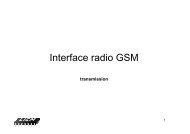Dependable Memory - Laboratoire Interface Capteurs ...
Dependable Memory - Laboratoire Interface Capteurs ...
Dependable Memory - Laboratoire Interface Capteurs ...
You also want an ePaper? Increase the reach of your titles
YUMPU automatically turns print PDFs into web optimized ePapers that Google loves.
70 CHAPTER 3. DESIGN METHODOLOGY AND MODEL SPECIFICATIONS<br />
CPI*/CPI<br />
5<br />
4.5<br />
4<br />
3.5<br />
3<br />
2.5<br />
2<br />
1.5<br />
1<br />
0.5<br />
0<br />
0<br />
Permutation Benchmark<br />
(Random Errors Injection)<br />
CPI*/CPI (seq_duration=10) CPI*/CPI (seq_duration=50)<br />
CPI*/CPI (seq_duration=100)<br />
0 2.00E-04 4.00E-04 8.00E-04 1.60E-03 3.20E-03 6.40E-03 1.28E-02 2.56E-02<br />
Error Injection Rate (EIR)<br />
Figure 3.18: Model-I: additional CPI for benchmark group II<br />
From the simulation results of graphs 3.24, 3.25, 3.26 the CPI*/CPI ratio is smaller than model-I.<br />
In graph 3.24 with SD of 10 when EIR varies from 2e-4 to 2e-2, the additional CPI increases only by<br />
50% (on y-axis CPI*/CPI is 1.5) which means the execution time increases by only 50% even when<br />
the EIR becomes 100 times higher. This shows a good performance for the proposed architecture.<br />
For example, if we accept increasing by 50% the CPI, with SD of 10 there can be 20 errors per 1000<br />
instructions whereas with SD of 50 there will be only 6 errors per 1000 instructions. Furthermore, the<br />
SD has a direct impact on the size of journal memory in architecture and subsequently on its area.<br />
3.7.3 Comparison<br />
A comparison between model-I and model-II is summarized up in table 3.1. In both models, the<br />
effect of rollback is more dominant in higher SDs like 100 and 50. For example, as VP occurs after<br />
every hundred instructions in the SD= 100 there is more chances of provoking errors which rises the<br />
CPI*/CPI ratio more rapidly as compared to SD = 10 and 50. Since there is a large interval between<br />
the two consecutive VPs there is more chances for error occurrence which on the other hand increases<br />
the rate of re-execution of instructions.<br />
From the performance point of view in model-II, due to parallel access to the memory and journal<br />
in read operation the overall efficiency of the system is increased resulting in lower CPI ratios at<br />
higher EIRs as compared to model-I. Therefore, no clock-cycles are wasted if data is not found in the<br />
Journal. It has a better performance than our previous model as shown in the graphs 3.24, 3.25, 3.26.



